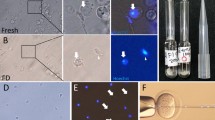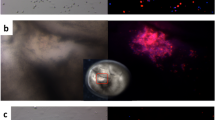Abstract
Nuclear transplantation and cell fusion techniques have proved valuable for embryological studies in several non-mammalian animal species1. More recently these procedures have been used successfully in small laboratory mammals, notably the mouse, to investigate the ability of nuclei and cytoplasm from various sources to produce viable embryos when combined2–6. The use of a similar approach to study the developmental biology of large domestic animals presents a number of technical and practical difficulties, and so far there has been no report of attempts to perform nuclear transplantation in sheep embryos. Here I describe such a procedure and its use to investigate the development of embryos in which whole blastomeres from 8- and 16-cell embryos were combined with enucleated or nucleated halves of unfertilized eggs. The procedure involves bisection of single-cell eggs in a medium containing cytochalasin; fusion of egg halves with single blastomeres, induced using Sendai virus or an electrofusion apparatus; and embedding in agar, followed by culture of the reconstituted embryos in the ligated oviducts of ewes in dioestrus. I show that fully viable embryos may be obtained by this procedure.
This is a preview of subscription content, access via your institution
Access options
Subscribe to this journal
Receive 51 print issues and online access
$199.00 per year
only $3.90 per issue
Buy this article
- Purchase on Springer Link
- Instant access to full article PDF
Prices may be subject to local taxes which are calculated during checkout
Similar content being viewed by others
References
McLaren, A. Nature 309, 671–672 (1984).
McGrath, J. & Solter, D. Science 220, 1300–1302 (1983).
Surani, M. A. H. & Barton, S. C. Science 222, 1034–1036 (1983).
Surani, M. A. H., Barton, S. C. & Norris, M. L. Nature 308, 548–550 (1984).
Barton, S. C., Surani, M. A. H. & Norris, M. L. Nature 311, 374–376 (1984).
McGrath, J. & Solter, D. Science 226, 1317 (1984).
Whittingham, D. G. Nature 233, 125–126 (1971).
Willadsen, S. M. in The Management and Diseases of Sheep (ed. British Council) 69–85 (Commonwealth Agricultural Bureaux, Slough, 1980).
Willadsen, S. M. in Mammalian Egg Transfer (ed. Adams, C.E.) 185–210 (CRC Press, Boca Raton, 1982).
Graham, C. F. in Proc. 3rd Karolinska Symp. on Research Methods in Reproductive Endocrinology Stockholm, 154–165 (1971).
McGrath, J. & Solter, D. J. exp. Zool. 228, 355 (1983).
Zimmerman, V. & Vienken, J. J. Membrane Biol. 67, 165–182 (1982).
Willadsen, S. M. Nature 277, 298–300 (1979).
Willadsen, S. M. J. Embryol. exp. Morph. 65, 165–172 (1981).
Author information
Authors and Affiliations
Rights and permissions
About this article
Cite this article
Willadsen, S. Nuclear transplantation in sheep embryos. Nature 320, 63–65 (1986). https://doi.org/10.1038/320063a0
Received:
Accepted:
Issue Date:
DOI: https://doi.org/10.1038/320063a0
This article is cited by
-
Sir Ian Wilmut 1944–2023
Nature Biotechnology (2023)
-
Measuring targeting specificity of genome-editing by nuclear transfer and sequencing (NT-seq)
Cell Discovery (2020)
-
Pregnancy and Calving Rates of Cloned Dromedary Camels Produced by Conventional and Handmade Cloning Techniques and In Vitro and In Vivo Matured Oocytes
Molecular Biotechnology (2020)
Comments
By submitting a comment you agree to abide by our Terms and Community Guidelines. If you find something abusive or that does not comply with our terms or guidelines please flag it as inappropriate.



